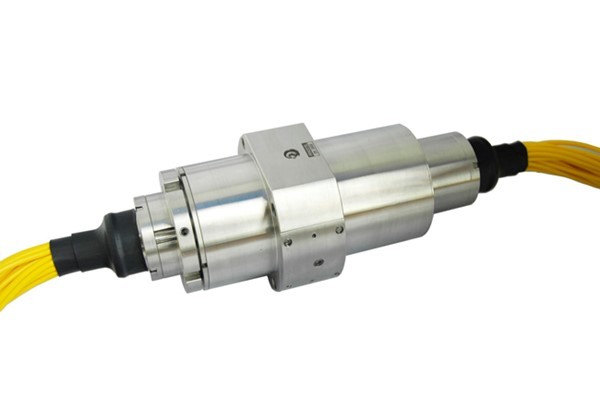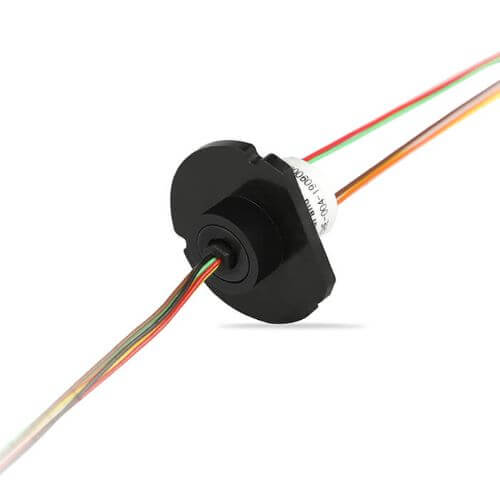Slip rings, often referred to as rotary electrical interfaces, rotating electrical connectors, collectors, swivels, or electrical rotary joints, are devices that are engineered to conduct electricity from a stationary part to a rotating part. In operations necessitating the continuous or intermittent rotation of a component, such as in wind turbines, radar platforms, assembly lines, or even in simple devices like an electric fan, slip rings are virtually indispensable. They provide a reliable connection while simultaneously allowing the freedom of movement—360-degree unrestrained rotation—something that a simple wire would not be able to cope with due to the inevitable wire twisting and subsequent breakage.
Yet, despite their widespread use and undoubted convenience, slip rings are not without their drawbacks. Over time, slip rings and brushes are prone to wear and tear due to the frictional contact that occurs in the course of their operation. This could lead to increased maintenance needs, system downtime, and potential electrical noise which can interfere with the quality of signal transmission. Furthermore, slip rings can be sensitive to harsh operating environments such as high humidity, extreme temperatures, dust, and vibration.
Hence, to alleviate these challenges, the pursuit of slip ring alternatives has become more pertinent than ever. Alternatives are increasingly viable with the progress of modern technology, offering solutions that reduce friction, improve signal integrity, and withstand harsh environments better than traditional slip ring assemblies. The search for alternatives is not only about replacing the traditional slip rings but also about finding more efficient, reliable, and tailored solutions that suit the dynamic demands of our evolving technological landscape. Thus, the necessity for slip ring alternatives is fueled both by the desire to overcome the inherent drawbacks of slip rings and the drive to innovate around the ever-changing needs of technology-based industries.
Types of Slip Ring Alternatives
To address the limitations associated with traditional slip rings, a range of alternatives has been developed. These alternatives leverage various transmission technologies: wireless, optical, and advanced mechanical solutions. The choice of an appropriate alternative depends on the specific needs and constraints of a given application.
Wireless Transmission Technologies
Wireless transmission technologies provide contactless communication between rotating and stationary components, contributing to the reduction of wear and tear, as well as maintenance.
- Inductive coupling: This method involves the use of resonant magnetic fields to wirelessly transfer electrical power and data between stationary and rotating components. Inductive coupling eliminates the physical wear and tear associated with traditional slip rings by utilizing contactless transmission. Additionally, this technology reduces the risk of electrical noise, ensuring better signal integrity than traditional slip rings.
- Radio Frequency (RF) communication: RF technology leverages electromagnetic waves to wirelessly transmit data between stationary and rotating parts. This transmission method provides a reliable option for contactless communication, significantly reducing maintenance costs and enabling more robust performance in challenging environmental conditions.
- Bluetooth: Widely used in consumer electronics, Bluetooth is a wireless technology intended for short-range data transmission and low power consumption. In some applications with less demanding power and data requirements, Bluetooth may offer a cost-effective and readily available alternative to slip rings.
- Wi-Fi: Wi-Fi operates on longer distances compared to Bluetooth, and offers higher data transmission rates as well. This technology can be employed in applications where continuous rotation mandates a wireless link for data transmission. However, Wi-Fi is less suited for low latency and immediate responsiveness.
Optical Transmission Technologies
Optical transmission technologies utilize light instead of electrical signals for data transfer. This eliminates the need for physical contact and provides resistance to electrical interference.
- Fiber optic rotary joints: Fiber optic rotary joints (FORJs) allow the transmission of data in the form of light pulses through optical fibers, achieving high data rates and eliminating electrical noise issues. FORJs are highly suitable for applications that demand real-time, high-speed communication or for systems with strict electromagnetic interference (EMI) requirements.

Mechanical Alternatives
Mechanical alternatives have been developed to reduce friction and wear, thereby enhancing durability and reliability.
- Brushless slip rings: Brushless slip rings, also known as contactless slip rings, use magnetic fields to transfer power and data instead of a physical connection. The absence of brush and ring contact decreases wear and tear, minimizes electrical noise, and boosts overall reliability.
- Electric swivels: Electric swivels contain swivel joints that transfer electrical power and data through brushes while rotating. This solution offers a longer lifespan compared to traditional slip rings since the use of brushes mitigates friction and wear issues. However, they’re still subject to some friction, unlike completely contact-free alternatives.
- Gas and liquid rotary unions: These specialized joints focus on transferring gas or fluid between rotating and stationary components. While they don’t facilitate electrical signal transmission like a slip ring, they provide an optimal solution for applications where the primary purpose is fluid or gas passage and not signal or power transmission.
Identifying a suitable slip ring alternative depends on various system and environmental factors, with the ultimate goal of improving performance, reliability, and compatibility with the specific requirements of a given application.

Factors to Consider When Choosing a Slip Ring Alternative
Slip ring alternatives incorporate diverse technologies with distinct characteristics and capabilities. Thus, there are several essential factors to take into account when choosing the most suitable alternative for your application:
Electrical and Mechanical Performance
- Transmission rate: This is the speed at which data can be transferred from the stationary component to the rotating component, or vice versa. Applications with high-speed data requirements, such as those utilizing advanced sensors or high-resolution video streaming, may need faster transmission rates.
- Signal integrity: This refers to the quality of the electrical signal being transmitted. Signal degradation or corruption—due to noise, interference, or signal attenuation—can significantly impact the performance and reliability of the application. As such, we must ensure that the slip ring alternative provides reliable and consistent signal quality.
- Power handling capacity: The power handling capacity indicates the amount of electrical power the device can safely transmit. Applications with high power requirements will need slip ring alternatives that can handle these demands without overheating or breaking down.
Environmental Compatibility
- Temperature and humidity resistance: Depending upon the environment where the application is located, it may be subjected to extreme temperatures and high humidity levels. Hence, the chosen slip ring alternative should be able to withstand these environmental conditions without their performance getting hampered.
- Dust, water, and chemical resistance: Some applications, like outdoor cameras or industrial gear, may be exposed to dust, rain, or even corrosive chemicals. In such cases, the slip ring alternative should have specific resistance ratings, such as IP or NEMA ratings, which denote the level of protection against dust, water, and chemical exposure.
- Vibration and shock tolerance: Certain applications may be subject to significant vibration or shock, such as in heavy industrial machinery or aerospace applications. The slip ring alternative should be designed to withstand these conditions without disrupting performance.
Size and Weight Restrictions
The size and weight of the slip ring alternative are crucial in applications where space is at a premium or where weight constraints could impact performance or safety, such as in airborne applications. The chosen technology should fit within the designated space and adhere to the weight constraints of the application.
Installation and Maintenance Complexity
The ease of installation and the level of maintenance required by the slip ring alternative can affect its long-term viability. A component that is straightforward to install and demands minimal maintenance can save time, money, and resources. Consider potential replacement costs, repair complexity, and the availability of spare parts when making the selection.
Cost and Budget Considerations
The monetary aspect of selecting a suitable slip ring alternative involves balancing between initial acquisition costs, installation fees, operation costs, and maintenance expenses against the allocated budget. While a high-quality, highly-performing option may seem expensive upfront, it might offer lower total costs over its lifetime due to reduced maintenance and replacement needs.
By carefully considering each of these factors, you can select a slip ring alternative that meets your specific needs and ensures reliable, efficient operation over the long term.
Slip Ring Alternatives: Users’ Most Common Concerns
When evaluating and implementing a suitable slip ring alternative, users are likely to express several concerns that merit consideration. These concerns revolve around performance, integration, support, security, and compliance aspects.
Reliability and Durability
A fundamental concern is the reliability and durability of the slip ring alternative. Users require a solution that provides consistent performance over time and can withstand normal wear and tear, reducing the likelihood of unforeseen failures and downtime. The chosen alternative should minimize the need for routine maintenance and ensure a long, cost-effective operational lifespan.
Compatibility with Existing Systems
Integrating the slip ring alternative with existing systems—which may include numerous components, like sensors, actuators, controllers, and software—is critical. Users want to ensure that the chosen alternative will seamlessly interface with other elements of the system, avoiding any costly or time-consuming modifications to the existing infrastructure.
Availability of Technical Support
Having access to an experienced and responsive technical support team is essential for many users. It is crucial to ensure a smooth and prompt resolution of any issues that might arise during installation, operation, or maintenance. This can significantly impact system uptime, response time for repairs, and the overall effectiveness of the chosen slip ring alternative.
Safety of Data and Signal Transmission
Users are often concerned about the safety and security of their data and signals during transmission. It is important for the chosen alternative to minimize or eliminate the risks associated with data loss or corruption and ensure secure, stable, and resilient communication. Moreover, in some applications, maintaining data confidentiality and safeguarding sensitive information might be a top priority, necessitating encryption or other security measures.
Regulatory and Industry Standards Compliance
Different industries have various regulations and standards that must be adhered to, particularly if the application involves safety, environmental, or quality control considerations. Users must ensure that the slip ring alternative complies with all relevant regulatory frameworks and industry-specific standards, such as FCC, CE, MIL-STD, or even customer-specific requirements.
Addressing these common concerns is fundamental to ensuring the slip ring alternative not only meets the users’ immediate needs but also provides a reliable, secure, and robust long-term solution for their applications. By acknowledging and addressing these concerns, users can make informed decisions when selecting and implementing a suitable slip ring alternative.
Case Studies: Real-World Applications of Slip Ring Alternatives
Multiple industries have turned to slip ring alternatives to address their rotating electrical connection needs. These case studies highlight some real-world applications:
Robotics and Automation Systems

Robotic and automation systems often require uninterrupted transmission of power and data while certain parts continuously revolve. While traditional slip rings could wear out quickly due to high rotational speeds and frequent direction changes, slip ring alternatives, such as wireless technologies or capacitive coupling, offer a prolonged lifespan and a reduced requirement for maintenance. Take, for instance, production lines that are heavily automated, where downtime could lead to significant production losses. The use of robust, low-maintenance slip ring alternatives enhances reliability and efficiency.
Medical Devices
In the medical field, devices such as MRI scanners leverage rotary transformers as slip ring alternatives. Such non-contact methods offer high reliability, zero electrical noise, and no maintenance requirements—essential features in medical imaging technology, where signal clarity is of utmost importance. The data integrity and zero maintenance offered by these alternatives translate into accurate diagnoses and smooth, uninterrupted operation, respectively.
Telecommunications Towers
Reliable, 24/7 data transmission is critical for telecommunications towers. In such cases, contactless slip ring alternatives, such as optical or radio frequency (RF) communication methods, offer an excellent solution. With their ability to endure harsh environmental conditions, these alternatives allow for efficient real-time data and signal transmission, contributing to consistent network service for thousands of users.
Offshore Wind Turbines
Offshore wind turbines are exposed to harsh environmental conditions and require rotating electrical connections that offer high durability and minimal maintenance. Inductive coupling, an ideal slip ring alternative, can successfully operate under these conditions. Not only does this lead to less maintenance and more uptime, but the robustness also means fewer replacement parts are needed, reducing overall costs.

Satellite Communication Systems
In the fast-moving world of satellite communication, preserving the integrity and security of data and signals is vital. Slip ring alternatives such as RF and optical transmission methods come into play in these high-speed, high-data environments. These technologies not only facilitate fast and secure data transmission but, being contactless, also demand minimal maintenance. Given the challenging operational environments, this leads to greater reliability and sustained longevity of the satellites.
Each of these applications exemplifies the utility and benefits of slip ring alternatives. They demonstrate how various industries have improved performance, reliability, and efficiency by adopting suitable alternatives over conventional slip rings.
Conclusion
Selecting the best slip ring alternative involves understanding the specific requirements, constraints, and priorities of the application. Recognizing these factors, as well as assessing user concerns, leads to optimized solutions that enhance performance, durability, and efficiency. Moreover, the potential growth and advancements in slip ring alternative technologies promise continuous improvement and innovation in the future.
FAQs about Slip Ring Alternatives
After considering the most common concerns users may have about slip ring alternatives, some frequently asked questions often arise. Here are some typical questions, along with their respective responses:
Basic FAQs Arising from User Concerns
Q: What are the main factors to consider in the reliability and durability of slip ring alternatives?
A: The key considerations for reliability and durability include the mechanism (contact/contact-free), the nature of materials used, and the technology’s resilience in the face of environmental factors like temperature, dust, moisture, and vibration. A reliable system maintains steady performance over time, requires less frequent maintenance, and exhibits a notable resistance to wear and tear.
Q: How compatible are these alternatives with existing systems?
A: Compatibility depends on the specific application and the nature of the existing systems. Many slip ring alternatives, such as those based on inductive coupling or RF communication, can seamlessly integrate with existing systems. However, for applications demanding particular signal types or power levels, specialized solutions might be required.
Q: What level of technical support can I expect?
A: This largely depends on the supplier or manufacturer but generally should include guidance for installation, troubleshooting, maintenance, and parts replacement. Validate the level of technical and customer support provided before making a commitment.
Q: How secure are these alternatives regarding data and signal transmission?
A: The security level varies across different technologies. While mechanical solutions might not inherently provide data encryption, wireless communication methods, like Wi-Fi or Bluetooth, generally incorporate data encryption.
Q: Do these alternatives comply with regulatory and industry standards?
A: Compliance often depends on the specific standard in question. It’s advisable to look for products that comply with relevant standards to your industry or consult with the supplier or manufacturer for confirmation.
Answers to Possible Queries about Slip Ring Alternatives
Q: Which slip ring alternative is best?
A: There is no one-size-fits-all answer. The optimal slip ring alternative depends on your specific application requirements, including data transmission needs, environmental factors, space constraints, and budget. Consulting with a knowledgeable supplier or conducting thorough research is advised to achieve the best fit.
Q: Are slip ring alternatives more expensive than traditional slip rings?
A: The upfront cost of slip ring alternatives can sometimes be higher than traditional slip rings; however, considering the reduced maintenance needs and potential for increased lifespan, the total cost of ownership may be lower.
Q: Do slip ring alternatives require regular maintenance?
A: Many slip ring alternatives, especially contactless options, require less frequent maintenance than traditional slip rings due to their lack of wear-prone mechanical parts. However, occasional system checks to ensure optimal operation are still recommended.
By responding to these FAQs, users can gain a better understanding of the considerations, capabilities, and nuances associated with the selection and use of various slip ring alternatives.
See What We Can Do
